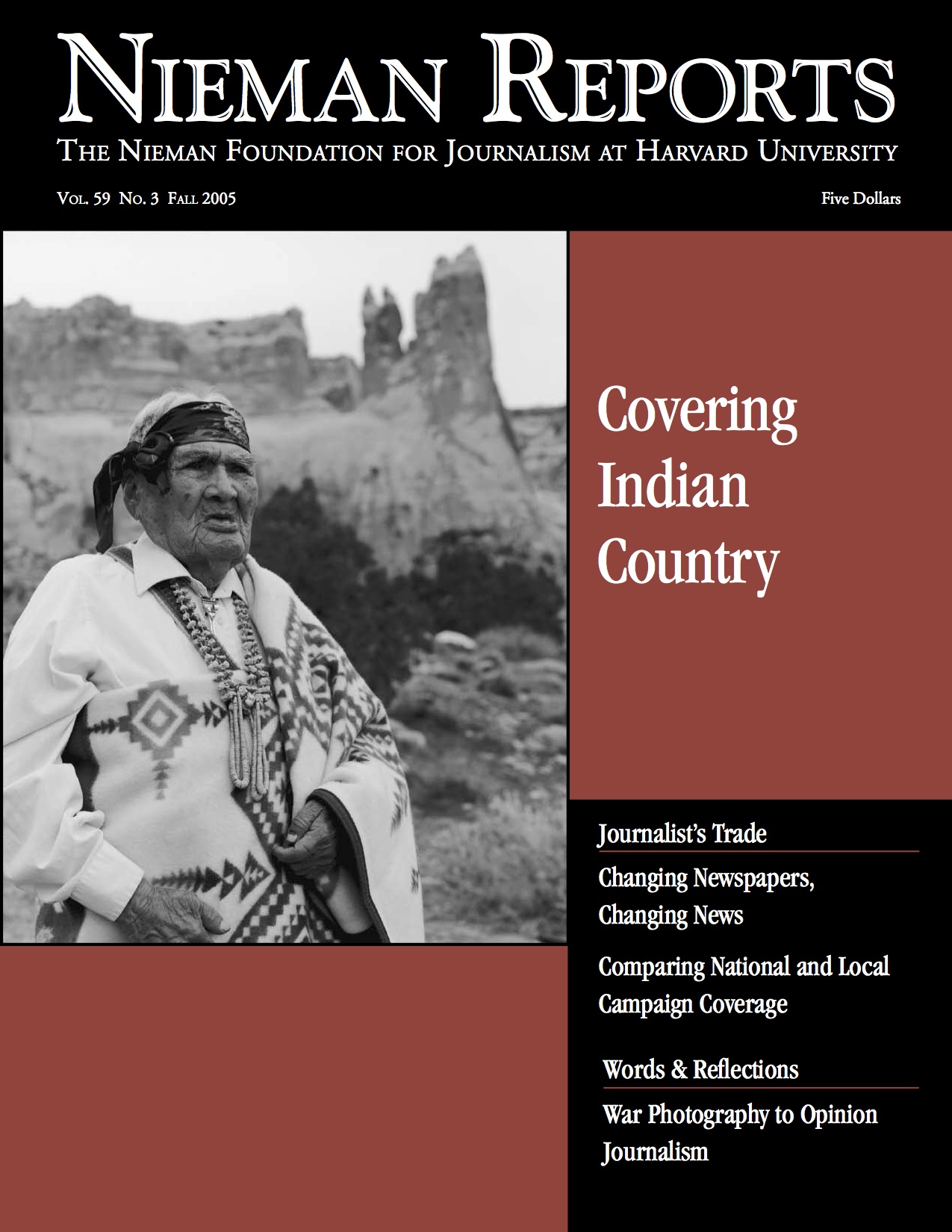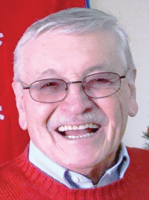What sets the Indian people apart from every other minority in America? Native Americans are the only ethnic group that lives on lands with clearly defined borders and boundaries. We have our own judiciary, law enforcement, and government. State governments have no jurisdiction on our sovereign nations. In the 1960’s, it became a bit more complicated when Public Law 280 allowed some states to assume jurisdiction on some Indian reservations. But in states like South Dakota the tribes convinced the voters of the horrendous cost and responsibilities they’d assume should that act become law, and it wasn’t passed.
The word “jurisdiction” is what creates the divide between the off-reservation media and many Indian nations. Because of logistics, language barriers, and a deep misunderstanding and mistrust of tribal governments, many newspapers have simply ignored the people of the Indian reservations. However every Indian reservation has state counties within their borders, and small newspapers spring up to take advantage of a county’s available advertising revenue. These papers usually carry little news about the tribal government or the people, but offer obituaries and tiny gossip columns.
On some reservations newspapers have been published sporadically, geared to specific causes or politics. The Crazy Horse News, published by Aaron DeSersa before and during the occupation of Wounded Knee in 1973, is an example of this type of effort. The American Indian Movement (AIM) sponsored this newspaper, which was used an as attack instrument against the elected government of the Oglala Sioux Tribe. Half-truths and innuendo that smeared tribal president Dick Wilson’s administration were often printed. The paper was clearly biased in its approach and was regarded as a political tool of the far left. The paper ceased publication upon the death of DeSersa in 1981.
Tribal Newspapers
Other publications, with their operating costs supplemented by tribal governments, have continued to flourish through the years. Some newspapers have crossed editorial swords with tribal leaders and vanished. One such newspaper, the South Piegan Drum of the Blackfeet Nation in Montana, published an article critical of the tribal chairman and soon discovered his wrath. He shut the paper down by cutting off its funding. Another paper, published by the Spirit Lake Tribe in North Dakota, asked the tribal council to publish the minutes of its meetings. The council refused. The editor, a non-Indian named Randy Howell, rushed his last publication to the printer and beat it out of town one step ahead of the tar and feather brigade. The center of his last edition held two blank pages containing only the words, “The Minutes of the Spirit Lake Tribal Council.”
In Navajo Country, the publisher of the Navajo Times, Loren Tapahe, decided to make that weekly newspaper the first daily Indian newspaper in America. It was a grand experiment. Considering the Navajo Nation covers 25,000 square miles and is located in four states, the effort turned out to be a financial disaster. Getting the paper to all of the far reaches of the Navajo Nation was hard enough once each week, but to try to do this five days a week proved to be cost prohibitive.
Tribal chairman Peter McDonald took a look at the dripping red ink on the budget, shut the paper down for a couple of weeks, fired the editor, Mark Trahant, and had the paper revert to a weekly publication. Trahant then decided to start a weekly newspaper he called The Navajo Nation Today to compete against the tribally owned Navajo Times, sincerely believing that an independent newspaper—unfettered by politics—could succeed. It lasted eight months. Advertisers refused to place their ads in it, and when he printed an article unfavorable to one of the largest mini-store chains on the vast reservation, the paper was thrown out of all of its outlets. Trahant lost half of his circulation in one day.
The Lakota Times
While working as a reporter for The Rapid City Journal, I was bothered by the fact that although I had been born and raised on the nearby Pine Ridge Indian Reservation, I was seldom given the opportunity to do news stories about the people of that reservation. One editor told me he believed that since I was Native American, I would not be able to be objective in my reporting. I replied, “All of your other reporters are white. Are they objective when covering the white community?”
By the spring of 1981 I had reached the point at which I knew I had to start a newspaper on the Pine Ridge Reservation. That reservation is 100 miles long and 50 miles wide with a population of nearly 20,000 people. It had no weekly newspaper to serve the people. I cornered my then-managing editor, Jim Carrier, and my editor, Jim Kuehn, and picked their minds for advice. They encouraged me to give it a try.
I moved back to the reservation and, using an abandoned beauty shop for an office and a $4,000 loan from a local bank, I published the Lakota Times. I chose the name Lakota for the people and Times because I admired the efforts of the Navajo Times. It seems strange now, but when our newspaper hit the stands on July 1, 1981, we became the only independently owned Indian weekly publication in America.
A former classmate from the Holy Rosary Indian Mission, “Dickie” Brewer, believed so strongly in the concept of a free press that he let me use his customized 1946 Plymouth for collateral to secure the $4,000 loan from Stockmen’s Bank in Rushville, Nebraska. The loan officer was a collector of vintage cars and knew in his heart that the bank would soon own that Plymouth. Instead, the $4,000 got the paper started, and the bank was repaid every penny it was owed.
When I started the Lakota Times, one strong belief guided me. Though idealistic and determined, I knew that if one is to ride into battle on a big white charger, it still takes a lot of money to buy the hay to feed that horse. With that in mind, we did something never done before in Indian country. We solicited advertising from Indian high schools, colleges, tribal government, the Bureau of Indian Affairs, and local reservation programs such as Head Start. We were also lucky. During our first year the Pine Ridge High School Thorpes won the state’s A level basketball championship for the first time since 1936. We went to every business bordering our reservation, to our tribal government, and to all of the other eight tribal governments in the state and got them to put in two-by-five inch advertisements to congratulate the Thorpes on the historic victory.
I also created a special tabloid issue that carried advertising for all of the powwows held in America. It was called “Hitting the Pow Wow Circuit,” and our second such tab was 68 pages (75 percent of which was advertising). This publication brought in more than $60,000. In 1998, the year I sold the newspaper, it grossed $1.9 million in advertising dollars. Not bad for a weekly Indian-owned newspaper. But it wasn’t easy.
Although our newspaper was located in Pine Ridge Village in the heart of the reservation, our hard-earned economic independence gave us the freedom we needed to report news as we saw fit and to write editorials critical of the tribal government, if the need arose. We also took a strong position against the violence perpetuated by AIM. Several murders and brutal beatings had taken place on the reservation since the occupation of Wounded Knee, and AIM members, many of them from tribes outside of our reservation, were causing problems the tribal government was trying to stem.
After I wrote a strong editorial in the fall of 1981, the windows of our newspaper office were blasted out with gunfire. We came right back with another editorial challenging the “cowards who strike in the middle of the night.” Two days before Christmas of that year firebombs were smashed against our building, which was saved when an alert Oglala Sioux Tribe police officer spotted the blaze and quickly kicked the burning bottles filled with gasoline away from the building.
It was pretty clear by now that bringing freedom of the press to Indian Country was not going to be easy. But we continued to publish every week, and we continued to strike out at violence and injustice. Our determination prompted tribal chairman Joe American Horse to call a special session of the Oglala Sioux Tribal Council at which he proclaimed that “from this day forward any attack upon the Lakota Times will be considered an attack upon the government of the Oglala Sioux Tribe.” It was a gutsy move for the president of the tribe to make, and American Horse can be credited for the eventual success of the first independent Indian weekly newspaper in the United States. To the credit of American Horse, the attacks upon the newspaper stopped.
The Lakota Times went on to win more than 50 awards from the South Dakota Newspaper Association, and investigative stories we published have caused banks to be fined and prospective rip-offs of the tribal government to be halted. It is now the largest Indian newspaper in America, reaching into 50 states and 17 foreign countries. In the process the Lakota Times proved that freedom of the press could not only succeed in Indian Country, but also that it can make a major difference in the way news is covered on the Indian reservations of America.
Sharing Lessons Learned
The major ingredient we brought to the Lakota Times is that we always viewed it as a community newspaper. Even though we eventually had news coverage from all nine Indian reservations in South Dakota, we always considered them to be one community. All of us grew up in the same fashion, which meant we lived in poverty and shared many of the same difficulties. In other words, we were Indian, and we thought as Indians, and our newspaper reflected that concept. I changed the name of the Lakota Times to Indian Country Today in 1992 to reflect its national circulation. After I sold the paper to the Oneida Nation of New York in 1998 many of my readers told me that the paper had lost its “Lakota soul.”
Now I am president of the Native American Journalists Foundation, Inc. Having been an active member of the mass media for several decades, I remain appalled by the lack of American Indian journalists in print and electronic media. This foundation provides journalism scholarships and summer intern programs for Native American students. By helping them get summer jobs at local newspapers and radio and television stations, we hope to spark that desire to pursue a career in journalism.
The foundation’s other objective is to hold at least three journalism seminars each year at different locations in America. At these gatherings we will bring Indian journalists and editors together to learn how to improve their radio stations and newspapers, how to sell advertising to give themselves more independence, and discuss ethics in journalism. Bill Kovach, former curator of the Nieman Foundation, Ray Walker, an editor with Knight Ridder Tribune News Service, and Richard Lee, former head of journalism at South Dakota State University, serve on our board of advisors.
After more than 30 years in journalism, it is time for me to pass on what I’ve learned to the next generation of Indian journalists.
Tim Giago, a 1991 Nieman Fellow, is the president of the Native American Journalists Foundation, Inc. and a syndicated columnist with the Knight Ridder Tribune News Service in Washington, D.C. Questions about the foundation’s work can be sent to: najournalists@rushmore.com.



